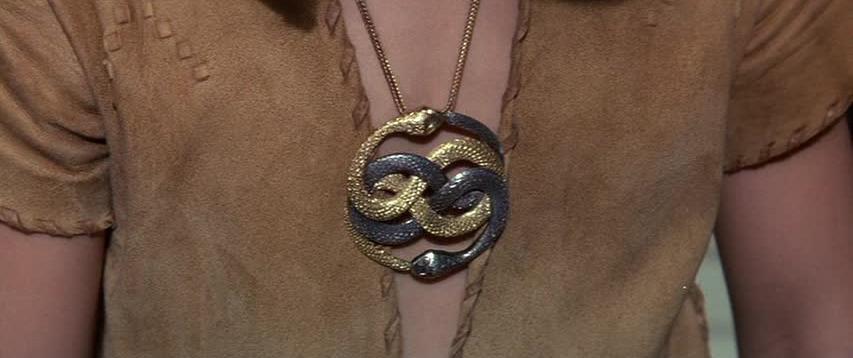A companion piece to Episode 112: Moon Child, written by Laurel Hostak
Part One of a two-part blog on the historical and philosophical influences on The Neverending Story
For Part Two: Platonism and Neo-Platonism in The Neverending Story, click here.
The Childlike Empress gives Bastian the last grain of sand in Fantasia
This week on the Midnight Myth Podcast, Derek and I discussed the 1984 fantasy classic The Neverending Story. Trying to deconstruct all of the mythological, symbolic, and philosophical subject matter in this movie is not a task anyone can be expected to undertake in an hour-long podcast, so this blog exists to expand on some of the ideas put forth on the podcast and introduce a few more. Specifically, I want to look deeper at The Neverending Story’s relationship to the history of alchemy and its roots in Platonic philosophy.
A brief overview of alchemy through the ages
When we think of alchemy, a few key images and concepts come to mind. The Philosopher’s Stone. The Elixir of Life. Transmutation. Charlatanism. This last one is difficult to exclude from conversations seeking clarity on alchemy, as by the 18th century the market was cornered by pseudo-alchemists who claimed mastery over the trade and exploited that status for superficial gain. But let’s rewind to the early development of alchemy for a bit and try to understand how it reached the interpretation it has today.
Though much of our modern perception of alchemy stems from its reputation in the late Middle Ages and Renaissance, we can trace it all the way back to the ancient world, specifically Egypt under Greco-Roman influence in the early centuries CE. Drawing from Greek, Roman, and Egyptian mythology, early alchemists began experimenting with the elements. But it’s not just myth and magic that gave birth to the alchemical tradition. Hellenistic Egypt, and its capital city of Alexandria, were a breeding ground for philosophical discourse and technological advancement. Early alchemy was influenced as much by Stoicism, Platonism, and the practice of metallurgy as by esoterica. While the common assumptions about the search for immortality and the transmutation of base metals into gold for self-enrichment are not entirely untrue, they’re only a small part of the complex truth of alchemical practice. Alchemists sought to purify and perfect materials, primarily metals, in the search for a universal solvent. This had special implications for medicine, as a major pursuit of alchemy was the development of a cure for any disease. It’s with these seemingly magical aims in mind—immortality, universal cures, transmutation—that the foundation was laid for early science and chemistry.
Alchemy emerged alongside and inextricably tied to an esoteric tradition known as hermeticism, so named for its foundational texts (collectively, The Hermetica) by the prophet Hermes Trismegistus, a figure who’s more myth than fact. His name, which translates to Thrice-Great Hermes, corresponds with the Greek messenger god of the same name, as well as the Egyptian Thoth, who’s associated with wisdom, magic, and science. (Note: Hermes’ symbol is called the caduceus. In Hellenistic Egypt, the caduceus, a winged staff entwined with serpents, was a chief symbol of alchemy. Today, it’s often used to represent medicine, something of a mistake due to its similarity to the Rod of Asclepius, which has historically represented healing.) Some of the hermetic texts were said to have been transcribed from the “Emerald Tablet,” a stone that fell from heaven and was inscribed with ancient doctrine. Hermeticism supposes the existence of a single, unifying theology that was given to man by God—however this knowledge is lost or hidden and must be uncovered through proper study and practice. Part of the inscription on the Emerald Tablet contains the aphorism “As above so below.” The phrase suggests a correspondence between earthly matters and the spiritual world or astral plane (think a sort of intermediary space between the heavens and the earth). Since a conceptual North Star of alchemy was the belief in a foundational material—an element, mineral, or substance that makes up all matter at its deepest core—the unifying doctrine aspect of hermeticism was an attractive spiritual corollary. Thus alchemy eventually took on the identifier as an earthly undertaking to align with astronomy of the heavens.
A rendering of the Emerald Tablet by Heinrich Khunrath, 1606.
Over the centuries, the practice of alchemy spread, gaining a foothold in India and the Islamic world as it waned in the West after the fall of Rome. It was in Asia that alchemy developed even greater associations with medicine, longevity, and the Elixir of Life. The discipline was likely introduced to the post-Roman European continent in the 12th century, finally reaching its height in Europe around the end of the Middle Ages and the early modern period. Renaissance alchemy realigned with its roots in hermeticism and Platonism and turned toward the individual and Humanism. In the 16th century, Philippus Aureolus Theophrastus Bombastus von Hohenheim, better known as Paracelsus, began experimenting with chemical remedies for physical ailments—he would become known as the “father of toxicology” for his contributions to the early medical movement. Paracelsus supposed that a balance of minerals and chemicals led to a healthy body (a microcosm) in accordance with nature or its environment (a macrocosm). As above, so below.
In addition to the basis of modern medicine, Paracelsus gave us another important creation: the gnome.
The Neverending Story as alchemical text
Engywook and Urgl, The Neverending Story
The gnome? What? The little guys that protect your garden? My character in an ongoing Dungeons & Dragons campaign? The fantasy creatures?
That’s right. Gnomes come from alchemical writing. Classified as a diminutive spirit, Paracelsus was probably the first to employ the term gnomus or gnomi in his writings on the elements. Each element (fire, earth, air, and water) gets its own elemental being (salamanders, gnomes, sylphs, and undines, respectively). In the gnome, he identified an earth-dwelling spirit and the basis for the spritely subterranean tinkerers of modern fantasy literature.
We happen to meet a pair of gnomes in The Neverending Story in the persons of Engywook and Urgl. Atreyu awakens from a long sleep in the company of the luck dragon Falkor, who delivers him to the gnomes for treatment. Urgl is a potion maker and doctor who tends to Atreyu’s wounds and weakness. Her medicines are based, like much in the mystical land of Fantasia, in magic, but it’s time-tested and effective. Her counterpart Engywook is a gnome of science. Living so near the Southern Oracle, he dedicates his life to the rigid scientific study of it. (For more on Engywook and Urgl, listen to the podcast!) The two gnomes, one a nurturing magical healer, and the other a scientist perfecting methods of observation and experimentation, represent two sides of the alchemical tradition and a deep misconception about their compatibility. I’ll come back to this in a moment.
A relatively close watch of The Neverending Story reveals numerous iconographic allusions to alchemy. Beyond the appearance of science and medicine-minded gnomes, one of the key symbols of the film is AURYN, the emblem of the Childlike Empress that also appears on the cover of the book-within-the-film/book.
AURYN
As we discussed on the podcast, AURYN, an image of two entwined snakes biting each other’s tails, is a version of the universally recognized ouroboros. Usually a single serpent biting or eating its own tail, the ouroboros first appears in the iconography of ancient Egypt, likely associated with the recurring cycles of rebirth observed in the natural world. Alchemy and hermeticism, also born in Egypt, appropriate the symbol to evoke the aforementioned universal element and the alchemists’ ultimate boon, the Philosopher’s Stone. The snake-eats-tail symbol doesn’t stop there, though; it’s versatile and evocative enough to find its way into illuminated manuscripts like the Book of Kells, appears in Norse mythology, and corresponds the Kundalini energy in Indic philosophy. The common threads are infinity and rebirth, especially as associated with cosmology or the natural world.
Aurora consurgens, a fifteenth century alchemical text depicting an ouroboros
So why, if the purpose of including the ouroboros only serves to describe the cyclical nature of The Neverending Story, does AURYN feature two entwined snakes instead of the traditional one? Perhaps it’s to suggest the unbreakable bond between the micro and macrocosm of the story—a link between the literary hero Atreyu and the “real-world” protagonist Bastian. Their parallel journeys intersect and bleed into one another, creating confusion about where one ends and the other begins. While I’d say this is certainly an aspect of the symbol, I’d also revisit the caduceus to find further significance.
Caduceus, the serpent-staff of Hermes and alchemical symbol
When not being mistaken for the Rod of Asclepius, the caduceus was the mythological serpent-staff of the Greek god Hermes. Our friend Hermes Trismegistus, legendary founder of hermeticism, carried the same staff entwined with two serpents. By combining the alchemical symbol of the ouroboros with the alchemical symbol of the caduceus, we’ve either got a hell of a coincidence or a hell of an elixir.
A high tolerance for ambiguity is necessary in the study of alchemy, just as it’s needed to appreciate the many levels of The Neverending Story. Seemingly incompatible disciplines like magic and science can share a home and inform each other’s development as Engywook and Urgl do. Likewise, the occult tradition of hermeticism can inform the development of harder disciplines like medicine, toxicology, and chemistry. I’d argue that it’s a mistake to think of these things as inherently separate or contradictory. Modern scholars tend to divide discussions of alchemy into opposing camps: the esoteric (concerning the spiritual, occult, and magical aspects) and the exoteric (concerning alchemy’s contribution to chemistry and early science or natural philosophy). But in the words of scholar Eric John Holmyard in Alchemy, “the two kinds of alchemy were often inextricably linked,” and exoteric alchemy “cannot be properly appreciated if the other aspect is not always borne in mind.”
So in alchemy, as in The Neverending Story, we have the unification of opposites and the establishment of correspondence between a micro and macrocosm. We have tension between airy, spiritual thinking in esoteric alchemy and the land of Fantasia, and the material thinking of exoteric alchemy and Bastian’s directive to “keep his feet on the ground.” The primary object of Atreyu and Bastian’s dual quest is a cure for the Childlike Empress’s mysterious illness; if she’s cured, Fantasia can be saved. Yet it’s impossible for Atreyu, the heroic warrior who lives in the world of Fantasia, to deliver the cure; he must unify with an otherworldly creature, the human child Bastian. This revelation is offered by the Southern Oracle in the form of a pair of sphinxes after Atreyu confronts a startling truth at the mirror gate. Purported to show the looker his “true self,” the magic mirror shows Atreyu the face of Bastian. They stare through metaphysical planes at each other, rupturing the sense of detachment and safety that stories can offer, and forging a new substance from the souls of the dual heroes…
The Magic Mirror Gate
“Engywook: Next is the Magic Mirror Gate. Atreyu has to face his true self.
Falcor: So what? That won’t be too hard for him.
Engywook: Oh, that’s what everyone thinks! But kind people find out that they are cruel. Brave men discover that they are really cowards! Confronted by their true selves, most men run away screaming!”
In Part Two of this blog, I’ll explore major concepts in Plato and Neo-Platonism, how they contributed to the development of alchemy—and how this relationship informs the core themes of The Neverending Story. Read Part Two here.
Sources
If you enjoyed this blog, check out some of our sources. Images are affiliate links, meaning if you purchase the item, a percentage goes to the podcast. Thank you for your support!














